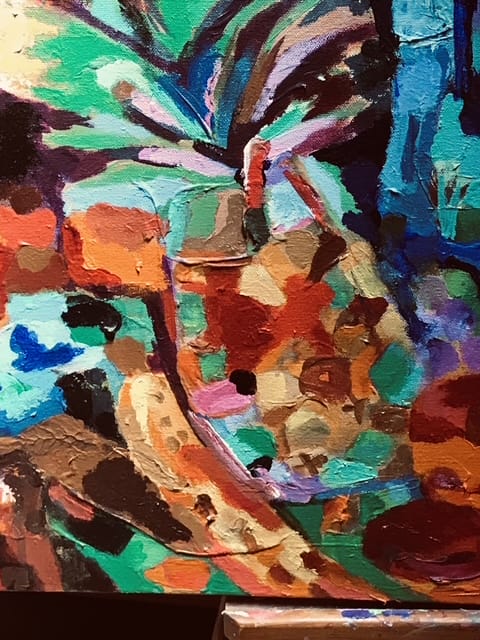Robert Evan Warman, who works under the name BoBbYReWiNd, grew up in suburban Chicago, where his fascination with art first began to take shape. Surrounded by the cultural richness of the city and its artistic communities, Warman developed a passion for exploring both visual and historical aspects of art. This interest led him to pursue an Art History degree at McGill University in Montreal, where he gained a deeper academic understanding of global art traditions and practices.
Following his studies, he traveled to Europe, immersing himself in the great museums and historic cities that have inspired generations of artists. These early experiences set the foundation for his later work, which often combines historical references with experimental techniques.
Guarding a Masterpiece: King Tut at the Met
In 1978, Warman’s career intersected with one of the most iconic exhibitions of the 20th century: the King Tutankhamun exhibition at the Metropolitan Museum of Art in New York City. Serving as a guard, Warman was in close proximity to the priceless treasures of ancient Egypt. This unique vantage point not only deepened his appreciation for cultural artifacts but also influenced his lifelong curiosity about how art connects civilizations across time.
The experience of literally standing watch over a world-famous collection reinforced his fascination with the dialogue between past and present, a theme that continues to echo through his body of work.
Artistic Development in Chicago
During the mid-1980s, Warman refined his practice through courses at the School of the Art Institute of Chicago (SAIC), one of the leading art schools in the United States. His growing confidence as a painter led to his inclusion in the 1984 Chicago and Vicinity Show, a major accomplishment that placed his work within a respected regional context.
This milestone marked the beginning of Warman’s visibility as an artist. Yet instead of following a conventional career trajectory, he chose to experiment and push boundaries, searching for new ways to integrate history, found materials, and personal narrative into his creations.
The Stationary Drawings and Cut-and-Paste Books
For the next fifteen years or so, Warman dedicated himself to an unusual and deeply personal project: creating drawings on museum stationary, primarily while living in New York City. These works carried with them the weight of institutional authority, as the stationary itself symbolized the museums that safeguarded art history. By repurposing this official material, Warman questioned the relationship between artist, institution, and audience.
At the same time, he embarked on a series of cut-and-paste art books. These experimental collages combined fragments of imagery and text from art publications, creating new narratives out of pre-existing material. This body of work demonstrated his interest in recontextualization—a process of taking something familiar and altering its meaning through juxtaposition, scale, and placement.
The Forest Park Series and Public Mural Work
In 2009, Warman entered a new phase of his career with the Forest Park Series, consisting of four acrylic paintings. This project marked a shift back to traditional mediums, but was infused with his years of experimentation. Around the same time, he completed a wall mural in Central Queens, contributing his vision to a public space where art becomes part of everyday life.
These works reveal his evolving approach: still rooted in history and assemblage, but more vibrant and outward-facing. His canvases began to absorb the spirit of his earlier cut-and-paste methods, as elements of assemblage found their way into painted form. The boundaries between painting and collage blurred, giving his work a layered, tactile quality.
Assemblage as a Core Practice
Assemblage has long been central to Warman’s creative practice. By combining disparate objects and materials, he builds visual narratives that are at once chaotic and harmonious. His assemblages often reflect the idea of cultural “integration,” where contrasting elements come together to form something new. This approach aligns with his philosophy that art should not be confined by rigid categories but should instead embrace multiplicity and contradiction.
Over time, this assemblage sensibility began to “bleed onto the canvases,” transforming not just the physical materials of his work but also his conceptual approach. His paintings became more experimental, less confined by traditional techniques, and more open to chance, texture, and juxtaposition.
Bridging Tradition and Technology: The NFT Era
True to his restless spirit of experimentation, Warman has recently turned his attention to the digital frontier of NFTs (non-fungible tokens). He is currently working on transforming photographs of his assemblages and details of his paintings-in-progress into blockchain-based digital artworks. This endeavor represents an attempt to merge the tactile, handcrafted qualities of his physical work with the possibilities of digital ownership and distribution.
For Warman, NFTs are not merely a technological trend but a continuation of his lifelong interest in recontextualization. Just as he once used museum stationary and art book fragments to create something new, he now repurposes digital images of his work, giving them new meaning and accessibility in a rapidly evolving art market.
Conclusion: An Artist in Motion
Robert Evan Warman, aka BoBbYReWiNd, embodies the spirit of an artist who refuses to be confined to one medium, one style, or one era. From guarding King Tut’s treasures at the Met to cutting and pasting art history into his own narratives, from painting murals in Queens to exploring NFTs, Warman’s career is a testament to the power of reinvention and integration.
His journey demonstrates that art is not a static practice but an ongoing dialogue between past, present, and future. Through his work, Warman invites us to reconsider the ways we preserve, reinterpret, and ultimately reimagine culture itself.


